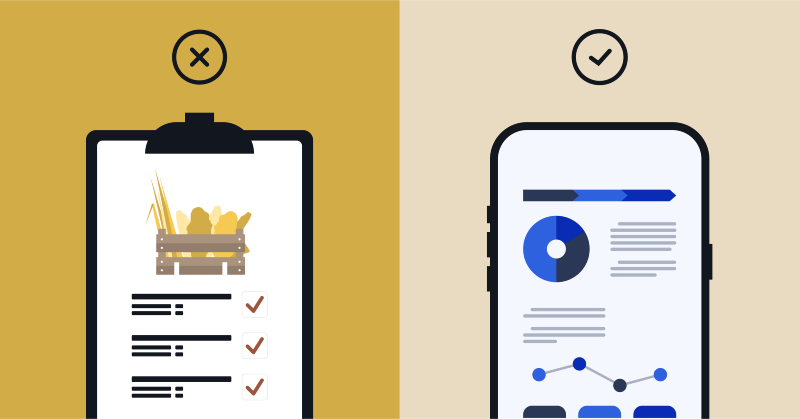
You know how it is.
You’ve just finished a monster service, you’ve cleaned your area until you can see your face in the stainless steel, and you’re more than ready to crack a cold one with the rest of the team.
Only, you’re not finished working yet.
You see, the thing about a busy service is it usually means there’s a big order to make, because you’ve just used up most of your stock.
So, whilst the rest of your team are kicking back, and enjoying a drink or two as they debrief about the shift just passed, you’ve got to go into the back with a clipboard and a leaky pen, and do a full stocktake.
It’s the last thing you feel like doing, but you know if you don’t, and you just guess at what you need to order (don’t lie to me, we’ve all done it), you’ll curse your past self for being so foolish, and the team will give you the moody eye the next day because your laziness ruined their workflow.
The fact is, inventory management is a very necessary evil, but it needn’t be so unpleasant.
In this piece, I’ll outline how an improvement in your inventory management procedures can not only save you time, but also money, touching on these key areas:
- A quick refresh on inventory management
- What’s your go-to method of conducting a stocktake?
- So, now you’re going to tell us what’s wrong with these stocktake methods, right?
- Let’s highlight how good inventory management software can be
- Still not convinced? How about some real business growth?
A quick refresh on inventory management.
Oxford dictionary defines inventory management as…just kidding.
Basically, inventory management can be anything you do related to keeping your venue stocked up, and ready to serve.
This can range from performing a stocktake, to storing your inventory, to ordering more stock. It’s all about making sure you’ve got enough stuff to put on the customer’s table.
Need to see how your par levels are going? That’s inventory management. Got to place an order before 7pm? Inventory management. Doing some quick FIFO in your fridges? What am I, a broken record? Guys, it’s all inventory management.
It’s possibly the most important link in your supply chain, and it’s a vital part of keeping your business running as smoothly as possible.
What’s your go-to method of conducting a stocktake?
Mine was frightfully analogue.
There was the classic: a clipboard-based approach, complete with a grubby pen on a string, where I’d check off boxes, and write in quantities on a slapdash spreadsheet I’d printed 20 copies of.
It was rigid, and wasteful. I’d always invariably forget to add an ingredient to the list, so I’d either write it on the bottom myself each time, or completely forget to check it, depending on how tired I was.
Because of this, my stocktake was very rarely comprehensive, and it caused me numerous moments of dread when I finally realised that I’d forgotten to order something due to my lack of attention to detail.
“…service would grind to a halt as we all looked underneath fridges for a single pen in the dark.”
Trusty whiteboard-marker method
There was also the trusty whiteboard marker method.
This required a nearby surface that could be written on easily, and wouldn’t have it’s finish ruined by having about 5 litres of dry-wipe ink scribbled on it every day.
I’d write down everything I ran out of, as I ran out of it. At the end of the day, I’d take a picture of the list I’d created mid shift, and then go off and order everything.
This worked a little better than the clipboard, but it still required me manually ordering inventory long after my shift had finished, and the list could get quite long sometimes, if I’d had a busy one.
Plus, pens have a remarkable ability to go missing in times of need (especially erasable Sharpies, it’s like a really inconvenient super power), so service would grind to a halt as we all looked underneath fridges for a single pen in the dark.
Phone, iPad and dirty screens
The final method involved me making a list either on my phone, or on the iPad.
Similar to the whiteboard method, I’d punch in any ingredient I ran out of, mid shift, and then at the end of the day, I’d have an accurate list of what I needed to order.
The main benefit of this method was the lack of a pen to lose under a fridge. The main drawback was, you ended up with the dirtiest phone screen in existence, which made me feel like a character from Oliver Twist, only I could get more food whenever I pleased.
So, now you’re going to tell us what’s wrong with these stocktake methods, right?
Yes. Yes I am.
And it’s all to do with time.
You see, the methods listed above all have that one thing in common; they cost you your time. And in an industry as fast-paced as hospitality, time is something of a commodity.
How often have we all dreamed of knocking off in time to catch a few waves in the summer, or a few extra drinks when the weather outside is somewhat less forgiving?
Or maybe having to constantly update a rolling shopping list mid shift throws off your rhythm? You spend another minute or so getting back into the fast lane, meanwhile the dockets haven’t slowed down.
You see, as cliché as it is, time will always equal money.
You, or whoever is doing your stocktake, needs to be paid for their time. And the more tired they are, the more prone to mistakes they’ll be, and the longer it’ll take to get your inventory up to scratch.
“My hands would get so cold I could barely hold the pen, and my order looked more like a doctor’s prescription.”
Maybe they missed something, as humans are prone to doing, and instead of doing one big stocktake every two days, they have to stay behind to run the rule over the cool room again to catch whatever they missed yesterday?
Plus, dry stocks and fridges can be tricky places to maneuver. Have you ever done a stocktake in a cool room? Outside of those 40+ days in the peak of summertime, it’s not fun. My hands would get so cold I could barely hold the pen, and my order looked more like a doctor’s prescription.
Ultimately, for me, my time was worth more than money. I value my downtime too much, and inventory management always seemed to have the ability to cut into it like nothing else. My work/life balance was becoming decidedly unbalanced.
So, for everything an analogue inventory management approach has going for it, perhaps it’s time to invest in something a little more cost-effective.
Let’s highlight how good inventory management software can be.
With good inventory management software, such as Lightspeed Purchase, your POS system can manage everything for you.
It’s as simple as setting up your inventory, setting the par levels, matching each product to its supplier, and…well…that’s essentially it.
Your POS system can see what is getting ordered, and it can automatically update your inventory levels as it goes. Once you’re running low, you can either get an alert (if you feel like you need to run a final eye over everything before ordering), or have an order generated for you (if you feel like you want to save even more time).
Because all of your supplier’s details are already there, orders can be placed automatically, or even remotely. No more staying back after the shift!
Still not convinced? How about some real business growth?
With the extra time you’ve got, you can invest that back into your business.
This could be via extra staff training to improve their knowledge, leading to better customer service. Better service means a better reputation, and a better reputation usually leads to one thing; more business.
It could go towards recipe development so that your menu remains fresh, and relevant. I don’t know about you, but I enjoy mixing it up a bit when it comes to dining out. Admittedly, my options have become more limited since Pizza Hut stopped doing dine-in (oh how I miss you, all-you-can-eat ice cream factory!) but my sentiment remains the same.
It could even go towards expanding your business to another revenue stream such as merch, or possibly a 2nd location. With the time saved from not reaching under the fridge with the long tongs, you can develop a line of merchandise to sell alongside your menu. It’s an extra revenue stream that’s not difficult to set up, and your new inventory management software can take care of your stock levels, so you’ll never run out. Plus, it’s a relatively easy sell (I unashamedly wear about 90% brewery merch, and I’ve been told that I’m ‘pretty cool’ more than once).
If you do find yourself with the enviable problem of too many customers, you’re going to need somewhere to put them. I know it’s technically still work, but nothing grows a business more than a 2nd location. We’ve all thought about it (usually after the first month, when you feel invincible), only now you have the time to plan it out properly.
My point is that taking away the time spent manually managing your inventory, means that you can focus on growing your business, instead of simply maintaining it.
With good inventory management software, it gives you the opportunity to ditch the clipboard, modernise your operations, and achieve some real business growth.

News you care about. Tips you can use.
Everything your business needs to grow, delivered straight to your inbox.


